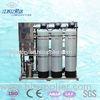FRP Tank 500LPH Desalination Reverse Osmosis Waste Water Treatment Plant For Home
What is Reverse Osmosis?
Reverse Osmosis is a technology that is used to remove a large majority of contaminants from water by pushing the water under pressure through a semi-permeable membrane.
Reverse Osmosis is the process of Osmosis in reverse. Whereas Osmosis occurs naturally without
energy
required, to reverse the process of osmosis you need to apply energy to the more saline solution. A
reverse
osmosis membrane is a semi-permeable membrane that allows the passage of water molecules but not the
majority of dissolved
salts, organics, bacteria and pyrogens. However, you need to 'push' the water through the reverse
osmosis membrane by
applying pressure that is greater than the naturally occurring osmotic pressure in order to desalinate
(demineralize or deionize) water in the process, allowing pure water through while holding back a
majority of
contaminants.

How does Reverse Osmosis work?
Reverse Osmosis works by using a high pressure pump to increase the pressure on the salt side
of the RO and force the water across the semi-permeable RO membrane, leaving almost all (around 95%
to 99%) of dissolved salts behind in the
reject stream.
The amount of pressure required depends on the salt concentration of the feed water. The more
concentrated the feed water, the more pressure is required to overcome the osmotic pressure.
The desalinated water that is demineralized or deionized, is called permeate (or product) water. The
water stream that carries the concentrated contaminants that did not pass through the RO membrane
is called the reject (or concentrate) stream.
As the feed water enters the RO membrane under pressure (enough pressure to overcome osmotic
pressure)
the water molecules pass through the semi-permeable membrane and the salts and other contaminants are
not allowed to pass and are discharged
through
the reject stream (also known as the concentrate or brine stream), which goes to drain or can be fed
back into
the feed water supply in some circumstances to be recycled through the RO system to save water.
The water
that makes it through the RO membrane is called permeate or product water and usually has around
95% to 99% of the dissolved salts removed from it.

What will Reverse Osmosis remove from water?
Reverse Osmosis is capable of removing up to 99%+ of the dissolved salts (ions), particles, colloids,
organics, bacteria and pyrogens from the feed water (although an RO system should not be relied upon
to remove 100% of bacteria&nb








